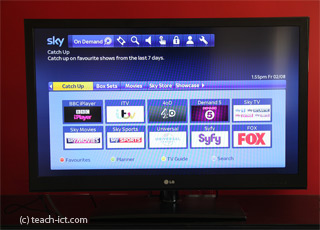3. Television screens
A television is quite a popular way of displaying IT or computer related output.

For example, video consoles connect to a television screen for maximum impact. Smart TVs connect to the internet directly and so can view content directly such as videos or catch-up services.
Every year the screen size available seems to become larger and now TV screens up to 60" or more are available.
A standard TV screen is '720p' which means it is 720 pixels down and 1280 pixels across. This is OK for displaying video but not so good for viewing text.
A 1080p screen is 1080 pixels down and 1920 pixels across which is far better for displaying text information. This is excellent for High Definition (HD) and Blu-ray content.
Uses of television screens:
- TV screens in the home
- As computer monitors for watching downloaded video / films
- Screens in public areas for information, advertising or displays
- Screens in video conferencing suites for meetings
| Advantages of plasma screens | Disadvantages of television screens |
|---|---|
| Very large screen size | Standard 720p resolution not good for displaying text compared to 1080p |
| Thin profile, sometimes only an inch depth. | Has to be viewed from a distance compared to a standard computer monitor |
| Large viewing angle (160 degrees) compared to LCD screens (40 degrees) | Large TVs need a lot of room around it for comfortable viewing |
| Brighter display than rear projection TVs | More expensive than a standard computer monitor |
| Unaffected by magnetism (unlike old CRTs) | |
| Can be mounted on a wall or free standing - more flexibility than other screens |
Challenge see if you can find out one extra fact on this topic that we haven't already told you
Click on this link: HD and Blu-Ray TV screen resolutions
